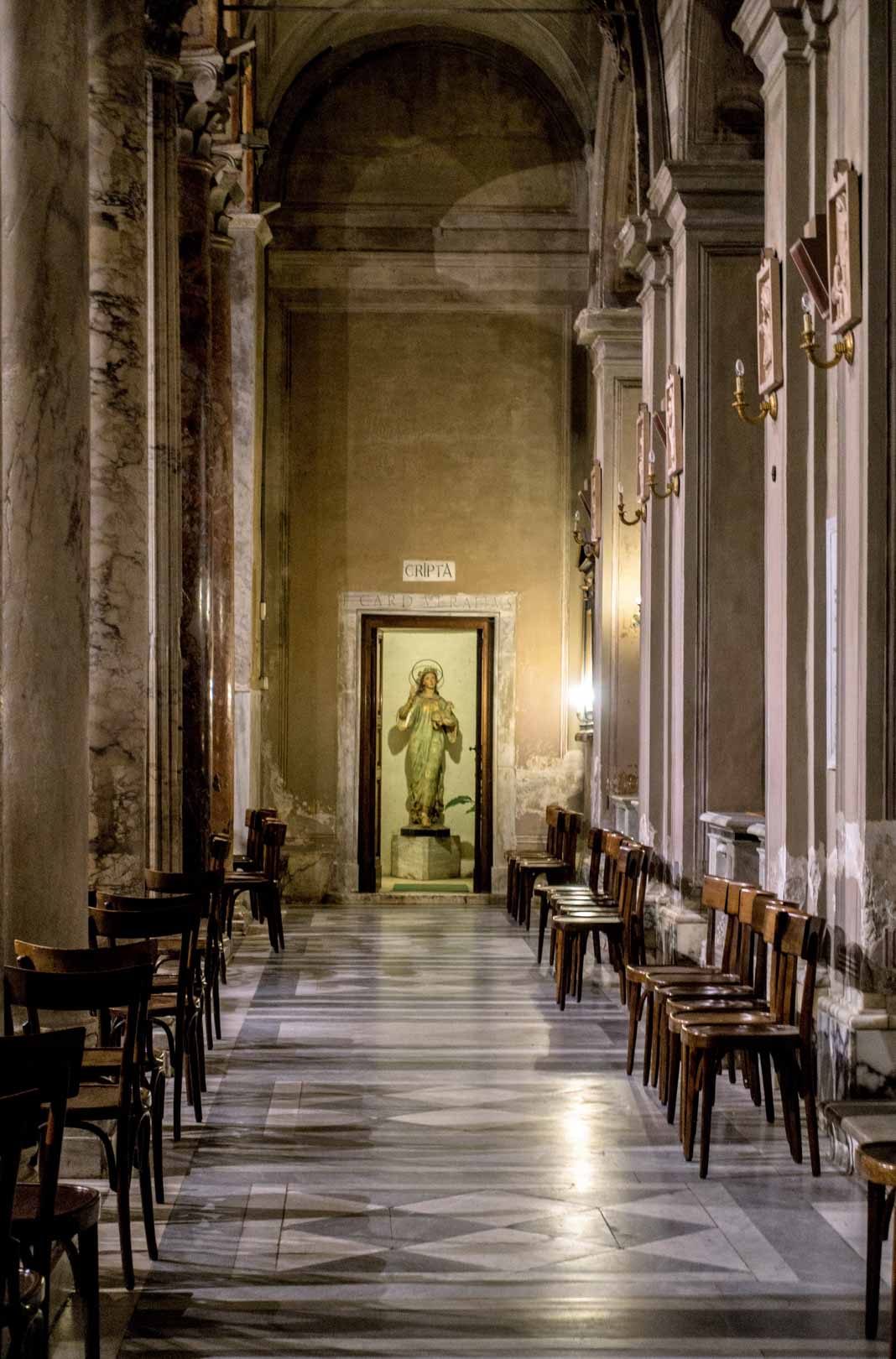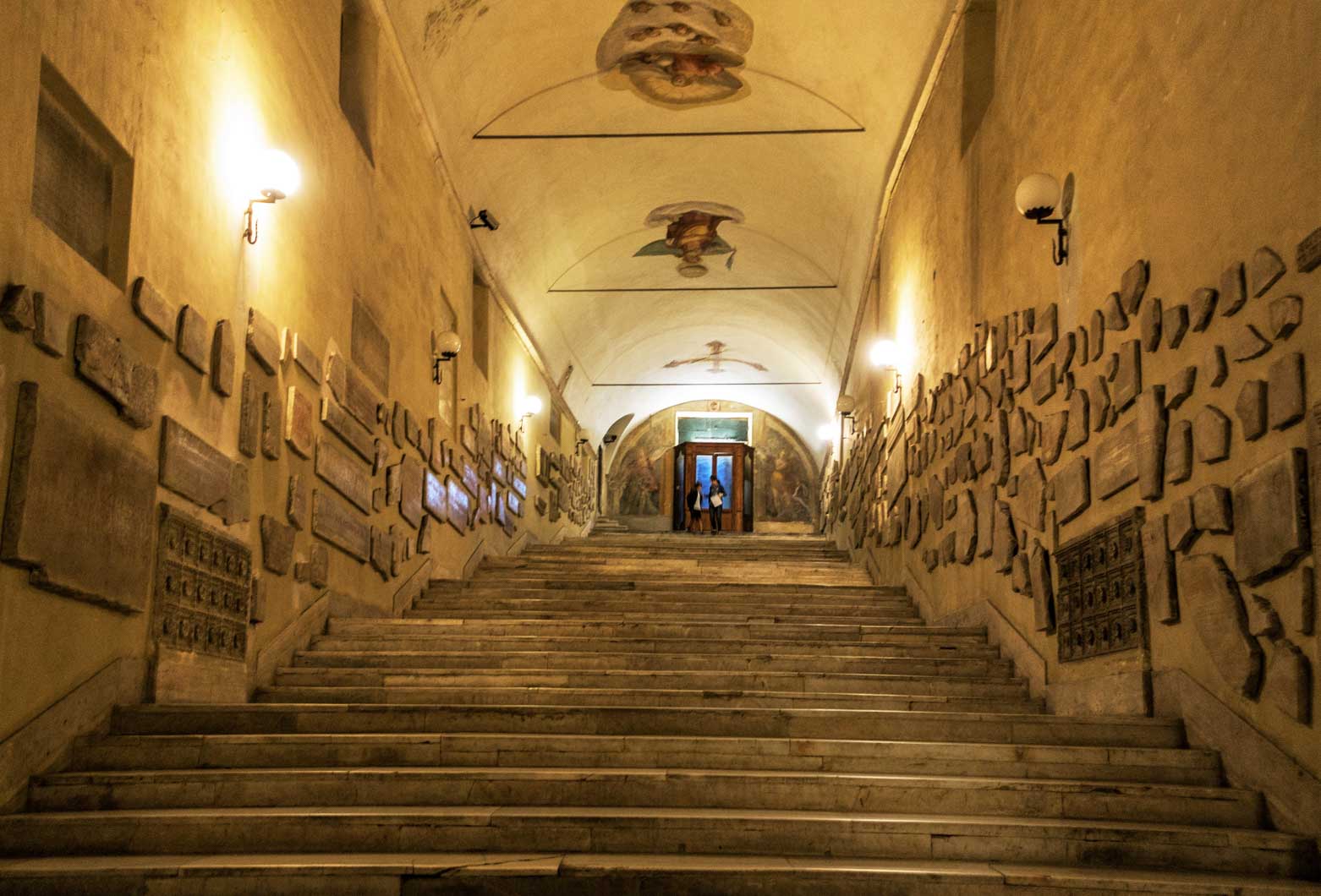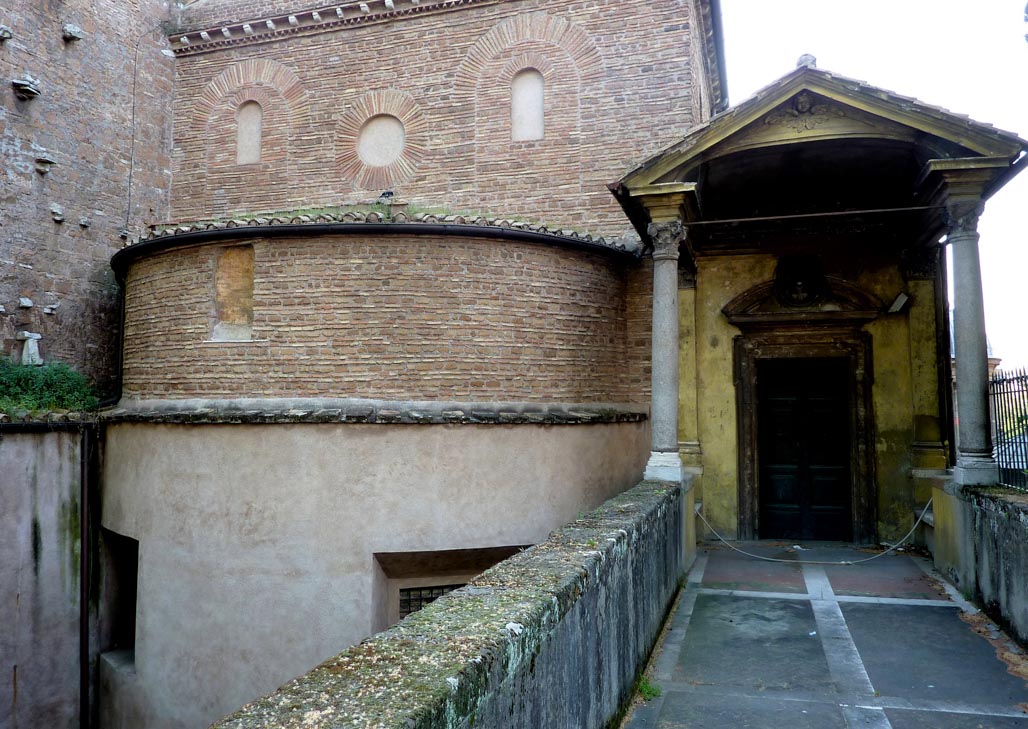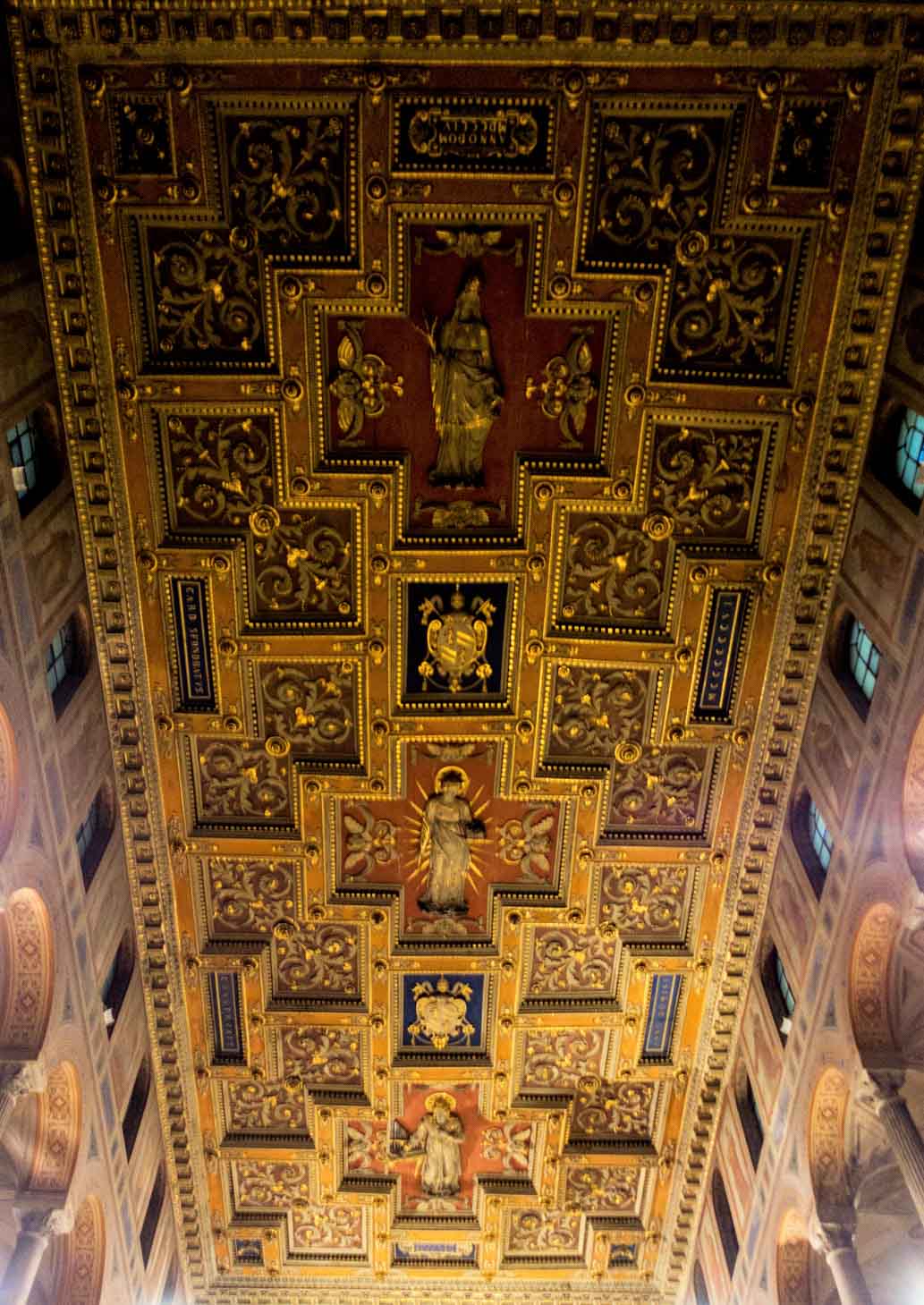
BUDOWLE & OBIEKTY Churches and chapels
Church of Sant’Agnese fuori le mura – a spiritual idyll on the outskirts of the city

The area, today belonging to the parish of the Basilica of St. Agnes Outside the Walls, which is located above the catacombs, which stretch for kilometers on end under the surface of the ground, in the past belonged to Roman emperors. Here in the IV century a mysterious cemetery basilica of Sant’Agnese was erected, which still today causes differing opinions among historians of antiquity and which is barely visible and overgrown with grass, while only ruined walls give testimony to the fact that this imposing in size structure existed at all. Its only well preserved part is the brick mausoleum of the daughter of Emperor Constantine the Great – Constantina, in time transformed into the a church (Santa Constanza), which as a result, saved this building from destruction, similar to that experienced by the cemetery basilica. When the end of the Roman Empire approached, both the afore-mentioned basilica, as well as the Catacombs of St. Agnes located here, fell into ruin. It was not until the cult of the martyrs which rapidly developed in the early Middle Ages and the fashion of visiting their graves, which was accompanied by pilgrimages, that this place experienced true renaissance. People came here to honor and to pray to St. Agnes, who was buried in these very catacombs. This required the location to not only be renovated but also to provide the appropriate setting, while also facilitating the movement of an ever-growing stream of visiting pilgrims. In order to meet those needs, as the initiative of Pope Honorius I, directly above the saint’s grave a church was built in the VII century which had a predominantly pilgrimage function. It was approximately 30 meters long and 12 meters wide, possessing an ambulatory, surrounding the main nave. The whole was topped off with an apse and embellished with galleries, meaning a type of balcony situated above the side naves. These galleries constituted an important element of the pilgrimage structure, since they were accessed directly from the street, which allowed large groups of people to enter the upper part of the church and gather around the altar, without disturbing the masses celebrated within. A second entrance was found, not like today in the church façade, but on its southwestern side – where, initially stairs, built most likely as early as during the times of Constantina, led to the catacombs.

Columns from various antique buildings were used in the construction and embellishment of Honorius’s church. Its interior was given additional splendor by adding mosaics, which unfortunately did not survive following modernizations and renovations – apart from a true pearl of the early medieval art, meaning the scenes depicted in the apse. Its lower semi-circle is decorated with porphyry and marble slabs, while the upper is filled with exquisite mosaics. St. Agnes, standing on a gold background with symbols of her martyrdom – a sword and flames twisting at her feet – is filled with the charisma of grandeur and dignity of an empress. Her dress encrusted with gold and decorated with precious stones and the diadem which rests on her head, are far removed from the image of a Christian martyr, while her tall figure and slightly smiling face with rosy cheeks, do not in any way fit the picture of a young, virgin martyr, which is how Agnes was described in the hagiographical lives of saints. On the left, she is accompanied by Honorius holding a model of the church which he funded. It is not only a votive offering, but also proof of the position of the pope, who after the fall of the Roman Empire and lack of imperial patronage, becomes a principal investor who commissioned sacral buildings. On the right of the saint we see Pope Gregory I the Great with a book – a great church authority while at the same time somebody who Honorius wanted to pattern himself after. Some historians see another pope in this figure - Symmachus. Nevertheless, the direct proximity of a saint to both the successors of St. Peter, unanimously shows the importance of the bishops of Rome. In this way a new iconographic motif is developed, in which figures of saint martyrs are accompanied by sanctified popes, even those who are still alive.

The majestic figures of both the hierarchs, are somewhat alike. The reflect sanctity, solemnity, but most of all in a dignified way represent the office which they hold. It is an excellent example of the adaptation of Byzantine art in Rome, in its derealization, hieratism, limited gestures and mimicry. Everything becomes a symbol in itself, while the gold background of the apse seems to emanate with divine glow, which in a literal way is further testified to by the hand of God appearing from the heavens, holding a wreath of martyrdom destined for Agnes.
In the apse, we can also notice a modest bishop’s throne, which can still be found in Roman churches today. It is the work of the Cosmati workshop (Cosmati style), but it relates to the oldest bishop thrones, from the IV century. Such a throne held a significant place in liturgy. The bishop who celebrated mass directed his steps toward it and sat on it surrounded by his presbyters. The porphyry columns, on the other hand, which top off the altar baldachin, previously served as supports of the ciborium which existed here.
As was the case with most medieval structures, this one too later underwent numerous renovations and modernizations. The first was carried out by Cardinal Giuliano della Rovere, the future Pope Julius II, at the end of the XV century, a thorough reconstruction of the monastery found here, and in addition he built a bell tower which is still in existence today. In 1606, the church got a new ceiling, which closed off the until now open roof truss. During the pontificate of Pope Paul V, in 1615 a baldachin over the altar was created, which was to underline the importance of the relics of St. Agnes found underneath, and which during that time were moved to the crypt. Under the baldachin we can see a figure of the martyr completed in 1605 by the French mannerist Nicolas Cordier, who was active in Rome. The artist completed his work in a rather atypical fashion. The antique alabaster torso, was accompanied by a head and lower portion of the saint’s robe cast in bronze.

In time, in the side naves of the church, six chapels were created, which were decorated and enhanced in the following centuries. Among the most interesting objects found within, are the images of two deacons, revered for centuries and very important to Rome – St. Lawrence and St. Stephen, found in the second chapel on the right. They were completed by the renowned sculptor of the early Renaissance Andrea Bregno (or his apprentices). The image of the head of Christ found in the same chapel is also of interest, completed by the afore-mentioned Nicolas Cordier. It is considered to be a copy of the work of Michelangelo (Michelangelo Buonarroti) himself.
Today, the church attracts tourists mainly due to the antique columns preserved within and of course the apse mosaics of exceptional beauty, but in the silence prevalent within, with the eyes of our imagination we will notice the interior from ages ago – full of mosaics shining with gold, also on the walls above the arcades, with a multi-colored floor by the Cosmatis, we will feel the scent of candles from the marble candleholders, while above our heads the ceiling with dark silhouette of the beams, will open up . This reverie can only come to an end, replaced by another vision just as distant in time – a church tightly filled with pilgrims, tired and carrying with them the smell of sweat and unchanged clothes, but happy since they have finally reached this distant church and Agnes – the saint martyr: prostrating themselves before her image, praying in loud voices, crying due to exaltation and religious emphasis. Today this space is filled with silence, which is only interrupted by the distant voices of children playing outside.
Może zainteresuje Cię również
Church of Santa Constanza (the mausoleum of Constantina) – a little known pearl of early Christian art
Zgodnie z art. 13 ust. 1 i ust. 2 rozporządzenia Parlamentu Europejskiego i Rady (UE) 2016/679 z 27 kwietnia 2016 r. w sprawie ochrony osób fizycznych w związku z przetwarzaniem danych osobowych i w sprawie swobodnego przepływu takich danych oraz uchylenia dyrektywy 95/46/WE (RODO), informujemy, że Administratorem Pani/Pana danych osobowych jest firma: Econ-sk GmbH, Billbrookdeich 103, 22113 Hamburg, Niemcy
Przetwarzanie Pani/Pana danych osobowych będzie się odbywać na podstawie art. 6 RODO i w celu marketingowym Administrator powołuje się na prawnie uzasadniony interes, którym jest zbieranie danych statystycznych i analizowanie ruchu na stronie internetowej. Podanie danych osobowych na stronie internetowej http://roma-nonpertutti.com/ jest dobrowolne.